When to harvest pumpkin in the Moscow region and how to do it correctly: features of growing and harvesting
Even the earliest ripe pumpkins do not fully ripen until 4 months after planting. At the same time, late-ripening varieties are considered especially valuable, dietary. But even in hot regions, such pumpkins need to ripen. Therefore, in the Middle Lane, including in the Moscow region, this vegetable is grown in seedlings.
When to harvest pumpkin in the suburbs to get high-quality, tasty fruits? You will find a detailed answer to this question in the article.
The content of the article
Features of growing and caring for pumpkin in the Moscow region
Pumpkin fully ripe on its own roots - this is possible only in the southern regions of Russia. But this does not prevent the successful cultivation of vegetables in the Moscow region, including on an industrial scale.
The pumpkin has a remarkable ability to ripen after being pulled off the bush. Only suitable conditions are needed: cool, dry and dark. After 1-2 months after removal, you can get a completely ready-to-eat fruit.
Important! Pumpkins ripened in the garden are tastier, so farmers often use the semi-greenhouse method of growing. The plant roots stay warm for a long time and allow the pumpkins to absorb additional nutrients. In this case, the scourge can be outside.
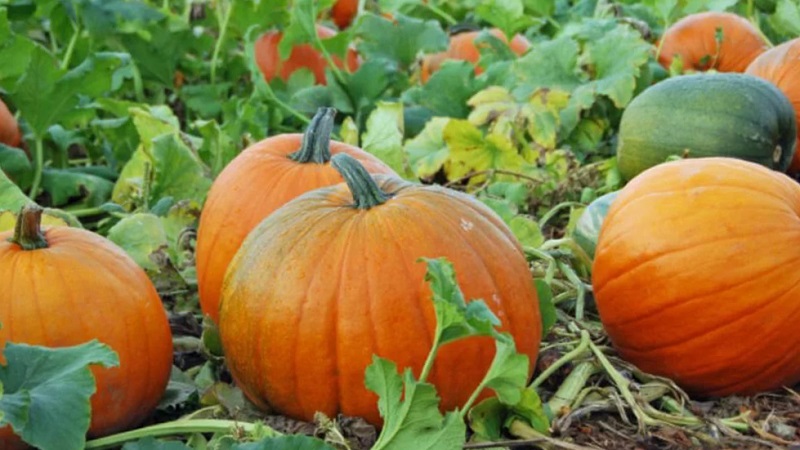
The best varieties for this region
The most delicious, nutmeg varieties are late-ripening, in the Moscow region they do not ripen on the vine. From nutmeg pumpkins, the Candied variety is recommended for the Moscow region. She has brown leathery with a waxy bloom, segmented fruits weighing up to 7 kg.
The keeping quality of the variety is 7 months after removal, the culture is adaptive, it can grow in different climates.
Of the late and mid-late varieties Atlant, Bolshoi Max, Moskvichka are suitable for the Moscow region. They grow well and are highly productive.
However, in the Moscow region, it is optimal to grow early and mid-season varieties.
Early ripe pumpkins:
- Freckle. Fruits are medium-sized, up to 3 kg, round-flattened. The color of ripe fruits is green, variegated due to the fine light yellow net.
- Gribovskaya bush. Oval, elongated, barrel-shaped gourds, more like large squash. Weight - 3-6 kg. Vegetables may be slightly ribbed or smooth. Ripe fruits have a bright color: on a light orange background, rich green, almost black, intermittent stripes.
- Therapeutic... Flattened, slightly segmented pumpkins weighing up to 5 kg. The crust is light gray with a dense network of dark gray spots.
- Marseillaise... Fruits are flattened, with segments, up to 8-15 kg. The bark is dark orange, smooth, no pattern.
- Olga... Fruits are smooth, segmented, medium-sized, up to 1.5 kg, ripen together. The bark is pink with a reddish marbled pattern.
- Parisian gold... It has segmented cream-colored fruits weighing up to 9-16 kg with a yellow spotted pattern.
- Motherland... The fruits look like a wide pear, smooth, orange, with weak segments, there is no pattern on the bark. Fruit weight - up to 5.5 kg.
- Russian woman... Fruits up to 1.9 kg, orange, smooth, pear-shaped, brittle, soft bark.
- Healing... Flat-round pumpkins with segments, standard orange color, smooth, average weight 3 kg (can reach 7 kg).
All these varieties are distinguished by a thin crust and a short shelf life of 1 month.
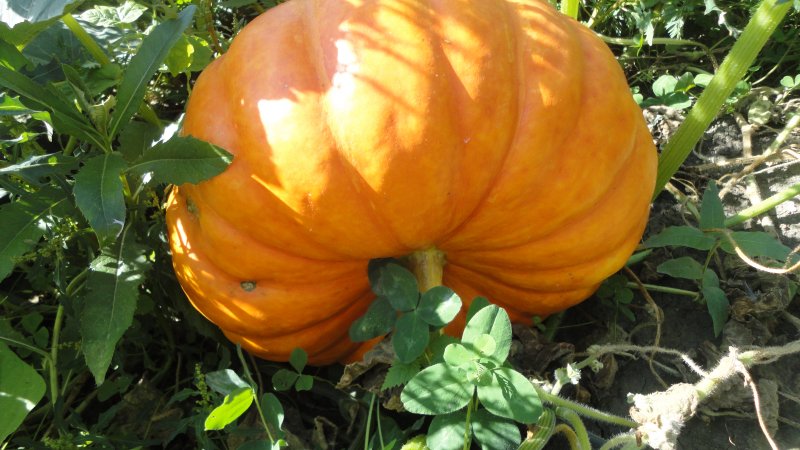
Mid-season pumpkins:
- Amazon... Fruits are smooth, round, with segments, weighing up to 5 kg, the color of the mature skin is dark creamy.
- Golden Dome... Yellow pumpkins weighing up to 10 kg, round, with weakly expressed segments, smooth.
- Gingerbread man... Classic round segmented orange pumpkins weighing 3.5-5 kg. The bark is smooth to the touch.
- Sweetie... Round, well segmented miniature pumpkins weighing up to 3 kg. The color of ripe fruits is dark red with a green spotted pattern. The surface of the crust of the ripe fruit is rough.
- Merchant's wife... Square, segmented pumpkins are light orange in color with cream spots. Smooth. The average weight is 3-5 kg, but some specimens can reach 13 kg.
- Smile... Bright orange small pumpkins for 1.5 kg. There is a subtle white stripe pattern.
Ripen for 4 months, stored for up to 2 months, many retain their taste and marketability for up to 3-4 months.
When to remove pumpkin from a garden in the suburbs
It is important to harvest the fruits before the onset of prolonged rains, dampness, frost. Pay close attention to the weather forecast. Lowering the night temperature to zero and below will damage the crop.
Harvesting time
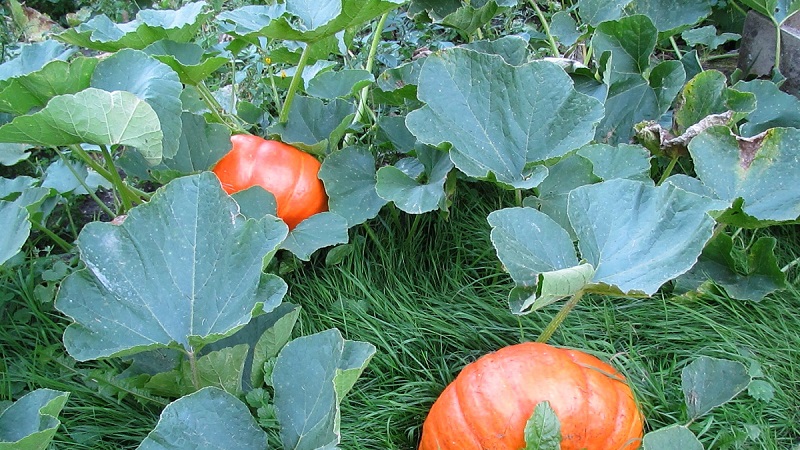
Pumpkins are harvested near Moscow until mid-September. Autumn in this region is too cold and damp for this vegetable, so it is strongly not recommended to leave the fruits in the open field for longer. The crop is harvested earlier if the weather forecast promises a cold snap and prolonged rains.
Early ripening varieties grown by seedlings can be removed at the end of August.
What determines the cleaning period
The basic principle is that the later the fruit is removed, the better. Naturally ripened pumpkins are tastier, sweeter and juicier. However, even in southern regions, they are often removed before biological maturity. If the deadline is missed, dampness and cold will hopelessly ruin the harvest. Even slightly frozen fruits are not suitable for ripening.
Often gardeners are guided by the generally accepted terms for the region. For example, in Crimea, the standard harvest time is late September - early October. Late varieties ripen indoors.
Exact calculation
To harvest at the optimal time, focus on the variety. On the package with seeds it is always indicated in how many days the fruits will reach technical ripeness. Technical maturity is the age at which the fruit has reached the desired mass, but the seeds have not yet fully ripened. Biological ripeness - the final ripening of the pumpkin.
reference... Volga gray from "Aelita" reaches technical ripeness in 120-121 days from the moment of sowing.
However, the period is indicated for ideal conditions, so when harvesting, you should focus on the weather and the condition of the fruits.
Auspicious days according to the lunar calendar
Auspicious days for harvesting this melon crop from the garden in 2019:
- July 23-27;
- August 19-25;
- September 8, 9, 16-21, 25, 26;
- October 3-6, 15-19, 22-25.
How to determine the ripeness of the fruit
When the growing season ends, the appearance of the plant itself and the fruits changes.
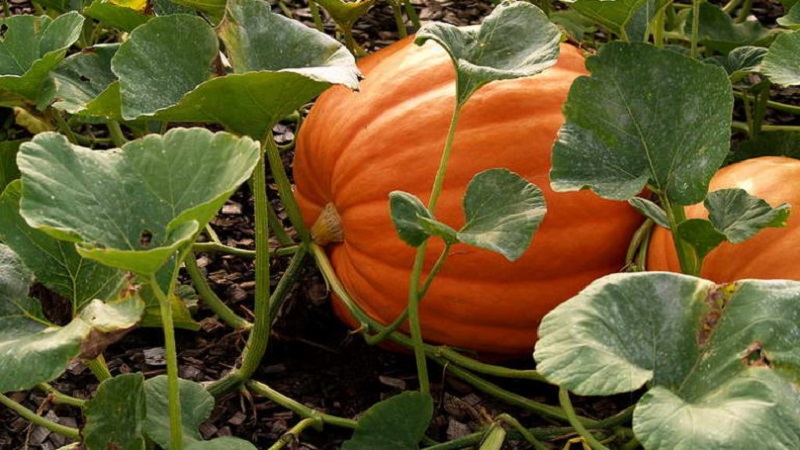
External signs
The optimal harvest time is determined by the appearance of the fruits. Pumpkins can be picked if:
- The leaves began to naturally dry out, dry out, turn yellow (not to be confused with yellowing and drying out due to diseases, for example, anthracnose).
- The crust of the pumpkin has become brighter, the color is well expressed, the pattern, if any, is clearer and more noticeable. This applies to varieties of any color. Even pumpkins with a gray crust take on a purer and clearer hue.
- The crust of the fruit is difficult to scratch with a fingernail.
- When pressed with a finger, the crust does not give in in any way, there is no feeling of springiness.
- The peduncle and the stem have become rigid, similar to the touch of a cork, have lost their flexibility. The pumpkin is difficult to move to the other side without damaging the stem. If the stalk is dry enough to scratch, the pumpkin is fully ripe.
- A waxy, dull bloom has appeared on the crust, and the stalk is easily removed. This is a fully ripe pumpkin.
Life hacks for verification
You can check the ripeness of the fruit in the following ways:
- Slap your palm on the surface... A clear, clear sound indicates that the pulp has reached the desired density and firmness, and the rind has hardened. A dull sound indicates that the pumpkin is not yet ripe.
- To check the ripeness of varieties with a gray-green color of mature fruits, the stalk and rind are evaluated. An unripe pumpkin will have a fresh stalk, while a ripe pumpkin will begin to dry out. The peel of a ripe pumpkin is dense, very rough in places, the relief is well expressed.
Harvesting rules
All pumpkin varieties are harvested following the general rules:
- When picking up, the weather should be clear, warm... Do not collect in damp and frost. But you shouldn't delay waiting for good weather either. If you had to cut pumpkins in the rain, wipe them with a napkin or dry them well.
- If the rains have begun, but there is no way to collect, the crop is covered with plastic wrap, so that moisture does not get on the pumpkins.
- The stalk is never cut to the root.... Such a fruit will quickly deteriorate, because the cut to the pulp opens the way for oxygen, bacteria, microbes. Be sure to leave the tip 3-5 cm. The cut of the tip should be even.
- Treat the pumpkin crust as carefully as possible. Any damage, even a minor scratch, reduces the chances of successful storage. Avoid falls that do not cause visible damage. From a strong concussion, the internal integrity of the vegetable will be violated, which does not contribute to keeping quality. One pumpkin that starts to deteriorate can cause damage to the rest.
- Large pumpkins are removed from the garden separately, they take longer to mature.
Further storage
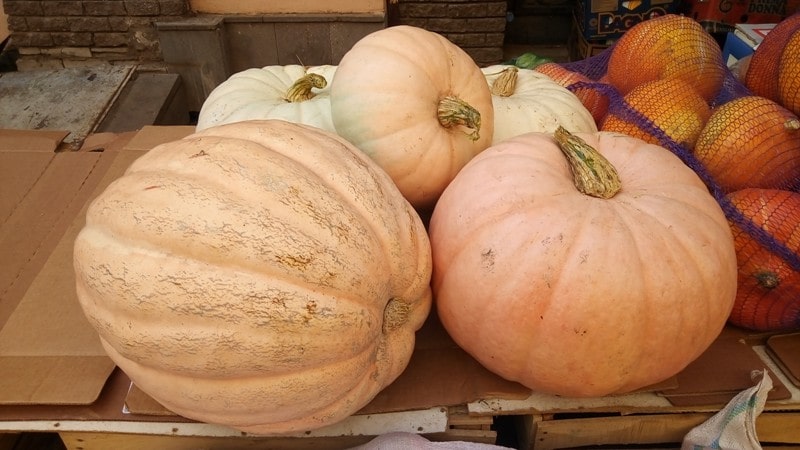
Before laying the pumpkin for storage, it is kept in a bright, warm room for 2-3 weeks. The temperature should be around 20 ° C. Under such conditions, the vegetable ripens, vitamins accumulate in it, the pulp becomes sweeter and more aromatic.
During storage, the following conditions are important:
- It is undesirable for the fruits to come into contact with each other.
- All damaged places, scratches, small punctures are covered with brilliant green.
- It is best to store deformed and injured vegetables separately.
- Good drying is especially important for vegetables harvested in the rain and for damaged specimens. The room should be about 28 ° C, humidity - up to 80%. Injured pumpkins will dry well under such conditions.
- The optimum storage temperature is 5-10 ° C. The room should be dark, dry, with good ventilation, humidity - no more than 80%. Usually these are basements, a balcony. Low light is acceptable. Bright light is undesirable: seeds may begin to germinate inside the fruit.
Ripening
If you need to bring a vegetable to full maturity, it is kept in a warm, bright room. But there are nuances:
- Make sure the pumpkin really needs ripening. In many varieties, even fully ripe pumpkins have a gray or green skin.
- Before laying for ripening, the fruits are carefully checked for quality and integrity. There should be no cuts, dents, scratches, or places that have begun to rot. It is better to use such fruits right away.
Seasoned Farmer Tips
Only in practice can you learn the secrets of growing vegetables. Experienced gardeners recommend:
- Do not overfeed the pumpkin with nitrogenous fertilizers, fresh organic matter. The fruits obtained from such plants do not differ in keeping quality.
- The most delicious seeds are from gymnosperms pumpkins.
- Spanish varieties are excellent guitar, Pink Banana, Miracle Yudo, Red Baroness, Marble, Volga gray, Matilda, Chit.
- Large pumpkins cannot be eaten at once, you have to store the pieces. An already cut vegetable is frozen or dried (in the sun, in the oven). Some gardeners manage to preserve the fruits in normal room conditions: at a certain temperature and humidity, the cut simply dries up.
Conclusion
Growing pumpkins in the Moscow region is fraught with a number of difficulties due to changeable weather conditions and a relatively short summer period. By choosing a suitable variety and providing conditions for the growth of this thermophilic melons and gourds, the gardeners of the Moscow region get a good harvest. Following simple recommendations, they manage to preserve this healthy vegetable without losing its nutritional and healing properties until spring.